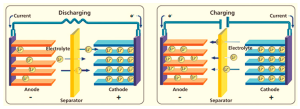Solar Battery Care, Maintenance and Safety
You have arrived to the correct place if you are new to renewable energy storage and don’t know what phrases like specific gravity and sulfation mean. We covered the several types of batteries that you could need for your solar energy system in our most recent post on solar batteries.
After selecting your batteries, you will undoubtedly want to maintain them to extend their lifespan. One of the greatest ways to extend the life of your solar batteries and lower the overall cost of your off-grid solar electricity system is to take proper care of them. Batteries that are not properly cared for might degrade and leave you without power in just a few weeks. We’ll start by going over the fundamentals of lead-acid battery theory so you can comprehend what is going on and, more importantly, what may go wrong inside your system. We will now go over how to handle your batteries properly, regardless of whether they are valve-regulated (VRLA) or flooded (FLA).
Knowing Your Solar Battery
Please continue reading if you need a refresher on batteries and find yourself rolling your eyes at the mention of high school chemistry. The electrodes, electrolyte, and separator are the three primary components of a battery. The name “cathode” refers to the positive terminal; it is easiest to recall if you spell it with a “ca+” The anode is the name for the negative terminal. It permits the transfer of charge between the anode and cathode. Consequently, the electrochemical reaction cannot be completed until electrons pass through the wire.
A sequence of lead plates, or electrodes, dissolved in a diluted sulfuric acid solution, or electrolyte, make up lead-acid batteries. Lead oxide (PbO2) in the positive plate’s oxygen atoms react with sulfuric acid (H2SO4) in the electrolyte’s hydrogen atoms during discharging. These will generate water, as you may presumably imagine (H2O). In the meantime, the anode and cathode also produce lead sulphate (PbSO4). Thus, in general, we may state that water is created and sulphate ions exit the electrolyte during discharge. Lead oxide is produced at the cathode during charging when the reaction proceeds in the opposite way. Overcharging can cause hydrogen to evolve, which increases the risk of an explosion because hydrogen is explosive. It is consequently essential to handle and care for batteries properly.
Maintaining your battery bank will require you to be aware of the many definitions and terminology used to discuss batteries.

Typical upkeep and care: how to maximize the performance of your solar batteries
Your battery’s performance and lifespan should be increased as a result of proper maintenance. The extremely variable attribute of battery life is dependent on a wide range of variables, including depth of discharge (DOD) and storage temperature.
Sulfation is the process by which sulphur crystals grow on the lead plates of batteries, obstructing chemical processes and accounting for about 80% of failures. Low electrolyte levels or battery charges can lead to sulfation. The hazards of sulfation in flooded batteries make it imperative to monitor, control, and regulate these two parameters. A digital voltmeter, a temperature-compensating hydrometer, distilled water, and the appropriate safety equipment are needed for this.
Recall that checking the specific gravity and fluid level of AGM and gel batteries is neither necessary nor feasible. Thus, the first two procedures are limited to flooded batteries.
Ways to Vertify the Fluid Level
This procedure should only be used for flooded lead acid batteries, or unsealed batteries (FLA). Remove the battery cap to see what’s inside. Once the cells are filled with distilled water, the metal lead surfaces should be completely hidden. A “fill line” designating the ideal electrolyte level is present on most batteries. There is about 1/2″ of fluid behind the cap at its highest point. A full battery should not spill, so don’t overfill them!
Ways to Inspect the Level of Charge
Verify the battery’s voltage and specific gravity to ascertain its state of charge, often known as its depth of discharge (DOD). You can find out how charged your battery is by using the specific gravity table below. In the event that your batteries are 6V rather than 12V, just divide the voltages by two. In a similar vein, double the voltage in a system with 24 volts.
Your battery will experience severe sulfation if you fail to keep an eye on these two parameters. In order to reduce efficiency losses in the event that this occurred, you might overcharge the battery as demonstrated in this YouTube video. However, the harm would not entirely be undone by this.
A Guide to Battery Cleaning
Battery terminal cleaner brushes should be used to clean battery terminals on a regular basis using a solution of baking soda and purified water. After that, give the terminals a quick wash with water, check that all of the connections are tight, and apply high-temperature oil or commercial sealant to the metal parts. Naturally, before cleaning, make sure the clamps are removed (negative first).
Party Manual for Batteries
Remember that ‘mixing’ can negatively impact the performance of your batteries, so be cautious when changing old ones. Combining new and old batteries will cause the latter to rapidly deteriorate to the condition of the former. Combining new and old batteries is therefore a major financial waste.






